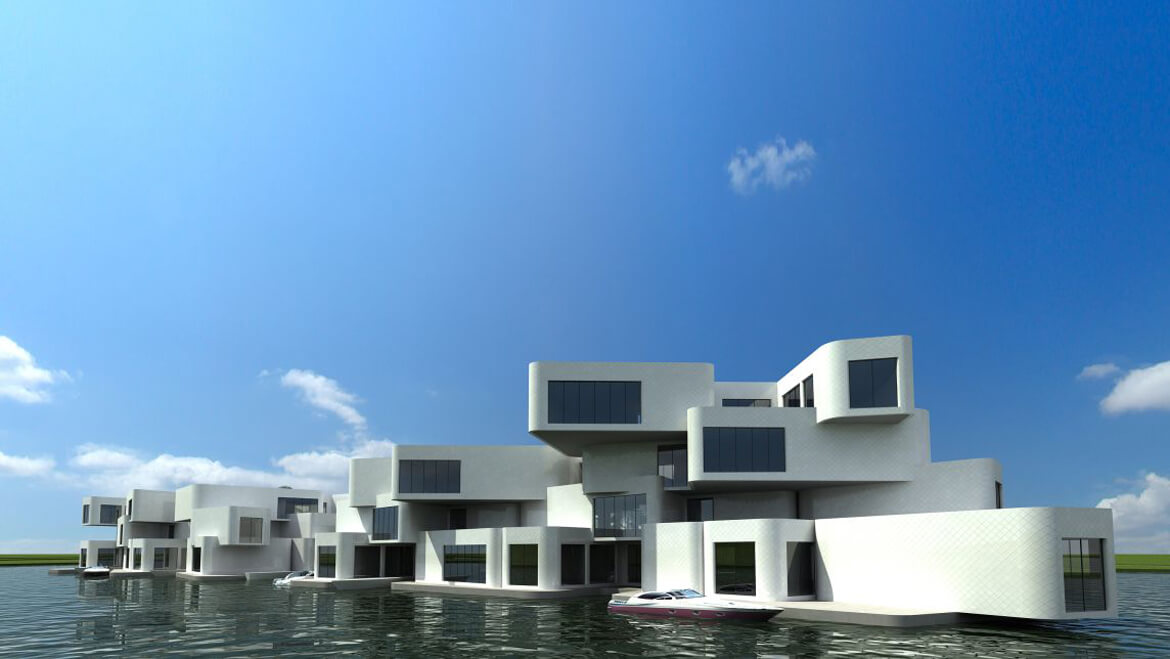Watervilla Aalsmeer, The Netherlands: now on sale
Watervilla Aalsmeer (The Netherlands) is now on sale!
For more info contact AWN Makelaardij(info@awn.nl ) Tel : 0294450752
click here for more information about the Watervilla
Watervilla Aalsmeer (The Netherlands) is now on sale!
For more info contact AWN Makelaardij(info@awn.nl ) Tel : 0294450752
click here for more information about the Watervilla

BostInno, Nate Boroyan, October 2013
A while back, BostInno told you that a floating Boston Harbor neighborhood next to Charlestown was being pitched to the Mayor’s office; a vision soon to be realized… in the Netherlands.
The Citadel, a luxury residential development by Waterstudio NL, is set to bring 60 stacked floating apartments to a patch of “low-lying land” that is kept artificially water-free by constant pumping. Construction could begin as early as 2014.
A report by the Harvard University Center for Environment previously stated, “Without action … rising seas will sooner or later alter most of civilization’s urban footprint,” suggesting that there might actually be a need for – rather than just creative inspiration to build – floating residences.
The HU report included information from a Graduate School of Design thesis by Michael Wilson (’07) suggesting a scenario where the sea-level could rise 6.6 feet, combined with a 100-year storm surge of 18 feet that would “reduce Boston… to a series of drumlins.”
Even a modest rise in sea level of 12 inches – expected by 2046 or sooner – in cahoots with a powerful storm, high tides and optimal winds, “would make Boston briefly part of the Atlantic Ocean,” the report added.
So. Not great. But innovative designs like the Citadel could help combat this terrifying prospect. Just ask the Dutch.
To be built on top of a floating concrete structure, the Citadel will provide residents of the Netherlands “easy” access to land and will include a car park. Made up of 180 modular components, the development will be built around a central courtyard, all of which sits atop six feet of water, which could rise to 12 feet.
Naturally, a portion of owners will have space designated to dock their boats.
There are 3,500 “polders” — chunks of low-lying land protected by dykes — in the Netherlands, so this development trend has the potential to go mainstream. Reportedly, 1,200 additional residential units are expected in the future.
Because floating apartments aren’t cool enough, units will also be energy efficient and feature green roofs for sustainability, not just additional awesome-points — but kind of.
With Boston, like the Netherlands, being among the world’s major port cities that could face a dramatic environmental crisis, urban developers and planners might need to develop a larger prevention plan.
But for now, let’s stick to wicked freakin’ sick floating homes, dood. (See above)
Yes, similar floating abodes like the Citadel have been discussed for Boston. Before any could become reality, however, there are a number of infrastructure issues that need to be dealt with, says Vivien Li, president of the Boston Harbor Association, during a phone call with BostInno.
Infrastructure concerns, such as waste and sewage management needs, and compliance with the Americans with Disabilities Act are not insurmountable; a ramp that adjusts to the floating tide, for example, would have to be built to allow disabled residents access to any floating development.
The bigger issues, Li said, are strict permitting regulations and residential financing.
Currently, developers are pushing for construction of new high-end apartments rather than luxury condominiums – reportedly more realistic for floating developments.
Financing for luxury condos, however, remains a bit less realistic. “Banks just are not financing condos right now,” Li said.
With Mayor Menino’s administration requiring 15-20 percent of residential developments units be “affordable,” areas such as the city’s Waterfront are booming with luxury apartments rather than condos, many of which, Li said, remain unaffordable for many.
A vote of confidence from Boston’s next mayor for floating residential developments could be a way for either candidate to “put a mark or a brand on his administration,” said Li, suggesting that either Walsh or Connolly could choose to take a creative approach when it comes to the affordable housing issue.
But…“Theory has to be translated into practice,” said Li. Despite a wealth of resources, thanks in large part to our myriad colleges and universities, this has yet to happen.
Thus far, only one floating development, suggested by Ed Nardi, the president of Cresset Development, has been discussed for the Boston Harbor near Charlestown. But that never gained traction, Li said.
High construction costs coupled with legal fees dished out to navigate zoning permits, Li said, would make a future floating neighborhood very, very, pricey — exclusive to Boston’s elites.
The silver lining is that an on-water development is doable, especially in the Boston Harbor.
Julie Wormser, TBHA’s executive director, called a Boston Harbor development a “viable option,” during a phone conversation with BostInno.
Even if another Hurricane Sandy or Nemo makes its way to the Boston coastline – and one will, eventually – the harbor is uniquely protected.
When Sandy struck, some coastal areas in the state saw 25-foot waves, Wormser said, adding the Boston Harbor didn’t see waves nearly that intense.
The harbor’s bowl shape and 34 islands requires hurricanes to travel on a “very particular path” in order to cause damage to the inner harbor, Wormser said. Hull’s Nantasket Beach and Deer Island are typically hit first, serving as Boston’s front lines.
Feasible? You bet. A popular idea? Wormser says, yes. Many others in the wake of Nardi’s Floatyard idea said differently. Will Boston have a floating development like the Citadel soon? Not likely.
After Menino takes his final bow, however, Connolly or Walsh could have something to say about that.

SURMOUNT, Mar 2012
SURMOUNT STYLE+COPY II/1-2 SET
ISBN: 9787561847053
Pages: 736p
Size: 245mm*325mm
Printing: Full Color
Publishing Time: May, 2013
Language: Chinese and English
Pub:TANGART
CONTENT
This is a chaotic and complicated information age, in which people are overwhelmed by large amount of mixed information from all times around the world. Now the distinct line between time and space becomes hazy; classic and avant-garde turn to be short-lived. People get tired and lost under the fast changing of aesthetics, value, life style, and etc. If residential design is a lifestyle customization which will fix someone’s living way, its key words should be how to balance the relationship among society, human and family.
* Nowadays, China and many developing countries are in the high-speed developing period, referring to not only economy, but also rapid changing in value and aesthetics for growth of knowledge and culture. How can residential design not only serve local people, but also satisfy international needs, not only reflect the features of times, but also back to people-orientation? This requires designers pay more attention to society and broaden their knowledge. Residence design has exceeded its own meaning and value; it not only has fundamental and completed functions, but also need to have more added values in order to reflect the significance of the various levels, meet the changing trends and get close to the modern people on the present and spiritual needs for future living space.
* Surmount Style+Copy has selected elaborately more than 80 outstanding works in major cities around the world designed by certain famous architects to fully demonstrate the tendency of global residence design. Architecture itself is an embodiment of thinking, which will show different meanings by different readers. We only have an analysis in basic aspects of façade, structure, ecology and sustainability, more deeper discoveries are waiting you to find in the book.